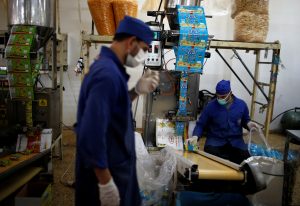
By Nidal al-Mughrabi
GAZA (Reuters) – The man who makes crisps, chocolate and vanilla snacks for Gaza had just finished explaining how his business was going through the worst economic crisis of his life when the lights went out, shutting down his factory. Again.
Wael Al-Wadiya has been running his food manufacturing business since 1985 – in a Gaza Strip that was very different from the one in which he and two million other Palestinians now live.
Back then Israeli settlers were still in Gaza, the Islamist militant group Hamas did not yet exist, and Palestinians were still two years away from the first of the uprisings against Israeli military occupation that introduced the word ‘Intifada’ to the world.
Sitting in a slowly declining industrial estate near the fortified border with Israel, the 51-year-old confectioner says that Gaza has been brought to a near-standstill by a decade of Israeli-led blockades, and internal Palestinian divisions.
“The situation is very miserable. People’s ability to buy has fallen to a minimum, therefore our businesses and businesses in Gaza are suffering as never before,” said Wadiya.

Palestinians work at Wael Al-Wadiya’s snacks and chips factory, east of Gaza City February 19, 2018. REUTERS/Mohammed Salem
He has cut production by 70 percent and wages by 30 percent. Employees who used to work each day now may work one day in three. “Unless a miracle happens, factories and companies will close down and it will be the real death of the economy,” he said.
There has long been poverty in Gaza, but with unemployment now at 43.6 percent, according to the Palestinian Bureau of Statistics, even once-wealthy merchants are defaulting on debts, causing other businesses to collapse, like dominoes.
Many in Gaza blame Israel for the hardships, accusing it of placing an economic blockade on the enclave that has drastically reduced the movement of people and goods.
But Gazans also fault their own leaders, complaining of a power struggle between Hamas, the armed group that seized military power in Gaza in 2007, and Fatah, the secular party of Western-backed Palestinian President Mahmoud Abbas.
Both Hamas and Fatah levy taxes. Both run competing bureaucracies. And even electricity has become a tool of political power – until recently the blackouts that plagued Wadiya’s factory were exacerbated by Abbas cutting money for Israeli current for Gaza.
Fatah says Hamas exploits money it collects from electricity consumers for its own purposes.
Israel, which pulled its settlers and soldiers out of Gaza in 2005, says it has been forced to control access to and from the territory to stop Hamas sending out gunmen and bombers, and from smuggling in weapons or material to make them.
The Israeli military says that it carries out “constant calculated risk management” between allowing humanitarian aid through to Gazans, while contending with Hamas, which “attempts to exploit the aid intended for Gaza’s civilian residents”.
POVERTY AND SECURITY
A combination of war, isolation, and internal rivalries has left Gaza in its current state.
Last year Abbas cut the salaries of 60,000 government employees in Gaza by 30 per cent, leaving them with little to spend in shops and markets after paying off bank loans. The sums of bounced checks in Gaza nearly doubled from $37 million to $62 million between 2015 and 2016, and then again to $112 million in 2017, according to the Palestinian Monetary Authority.
This lack of buying power contributed to a drop in imports through the one remaining commercial crossing with Israel, with just 350 truckloads per day compared with 800 in the last quarter of 2017.

Palestinian children play as a girl held by her mother looks out of the window of house in the northern Gaza Strip February 12, 2018. REUTERS/Mohammed Salem
Some merchants took a religious initiative in December in which they offered to write off customers’ debts using the hashtag ‘Sameh Toajar’ – ‘Forgive, and Be rewarded (by God).’
It was supported by Hamas and other factions, but the scale of the debts was too great for such a small-scale remedy.
“Gaza has gone into clinical death and is in need of root solutions, real and sustainable, and not temporary or short-lived solutions,” said Maher al-Tabba, a Gaza economist.
At the other end of the economic scale from the merchants are Suhaib, Shadi and Ahmed al-Waloud, who scavenge through garbage near their home in northern Gaza searching for plastic to sell to recycling plants.
Their father was one of the Gazans who lost their jobs in Israel more than a decade ago when Israel closed the door to thousands of Palestinian workers following Hamas’s seizure of control.
“I have been used to doing this job since I was a child,” said Suhaib, 19, from Beit Lahiya. But they now earn just enough to “stay alive,” he said, because the price paid for second-hand plastic has fallen by 80 per cent. “Nowadays there is not much work. People are not throwing away a lot of plastic.”
The question that dominates Gaza is whether hard times will make Palestinians more inclined to support attacks on Israel, or less so, because they fear reprisals.
Ali al-Hayek, the chairman of the Palestinian Businessmen Association in Gaza, said that total collapse of the economy would lead to instability that would be in nobody’s interests.
“Gaza is living through a real humanitarian crisis,” he said. “An economic collapse will lead to a security collapse that will cause trouble for the international community and for Israel.”
(Reporting by Nidal al-Mughrabi Writing by Stephen Farrell, Editing by William Maclean)












